Solar radiation storm, CME produced by M4.2 flare expected to hit Earth on May 11
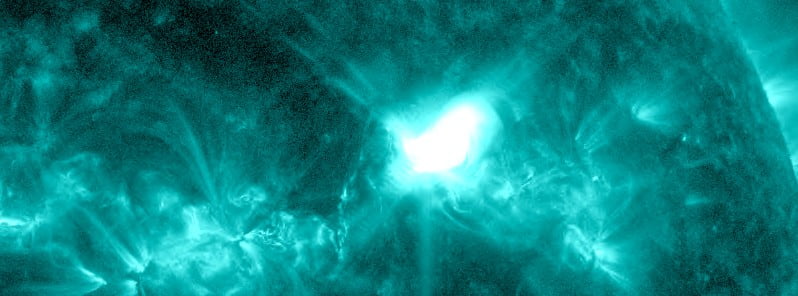
High solar activity was observed on May 10, 2023, primarily due to the enhanced flare potential of Region 3296. The most significant event from the region was an M4.2 flare, which resulted in a well-defined partial halo Coronal Mass Ejection (CME) signature, expected to hit Earth sometime after 18:00 UTC on May 11. The 10 MeV proton flux peaked at 38 pfu, dropped below Minor – S1 solar radiation storm levels by 12:35 UTC on May 9, but still above average, and then rose back over the 10 pfu threshold due to the May 7 CME passage.
The solar activity observed in 24 hours to 00:30 UTC on May 10 reached high levels, with the background X-ray flux still at C-class levels. The number of numbered sunspot groups on the visible solar disk increased to nine. Region 3296 (beta-gamma-delta) experienced significant growth and increased magnetic shear, gaining a clear delta signature within the intermediate area of the spot group.
This region has been highly active and was the source of multiple M-class flares, including an impulsive M6.5 flare at 03:54 UTC on May 9. Various radio bursts and a Type II radio sweep, as well as a Type IV, seemed to be associated with this flare.
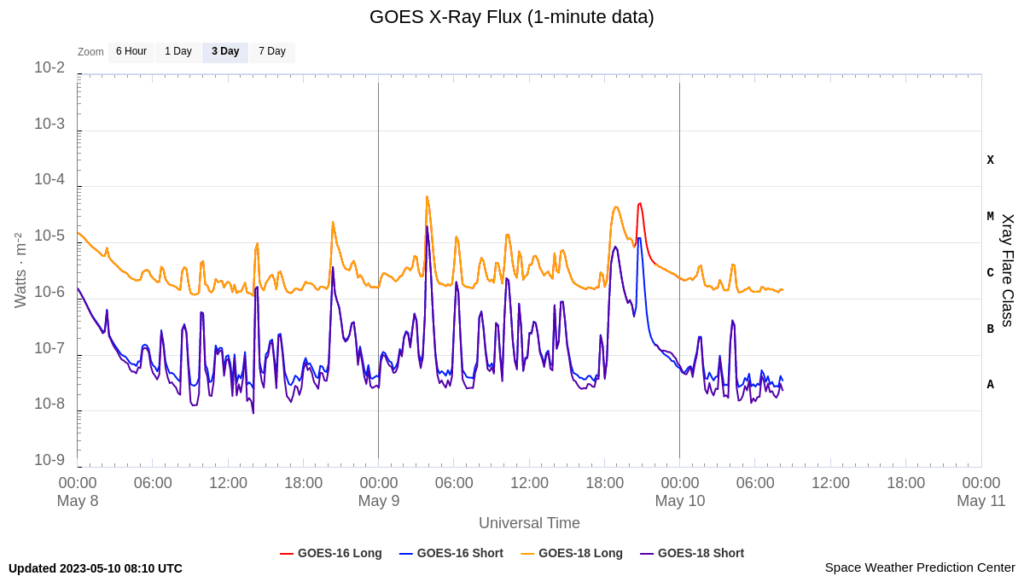
However, the most significant event from the region was the M4.2 flare (R1 – Minor) event, which was notable due to its well-defined partial halo CME signature (with full halo shock) observed in NASA/SOHO LASCO imagery. Multiple radio bursts and Type II and IV sweeps were also observed in relation to this activity. The analysis is underway for this latest notable CME.
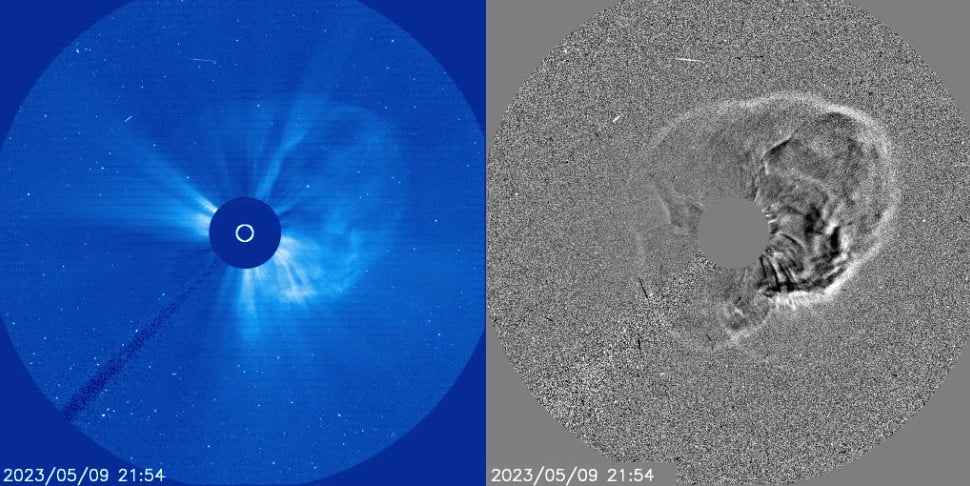
The greater than 10 MeV proton flux was at S1 – Minor levels, peaking at 38 pfu before declining and decreasing below S1 levels by 12:35 UTC on May 9, but remaining enhanced above background. Conditions then increased back over the 10 pfu threshold as a result of the May 7 CME passage. The greater than 2 MeV electron flux was at normal to moderate levels.
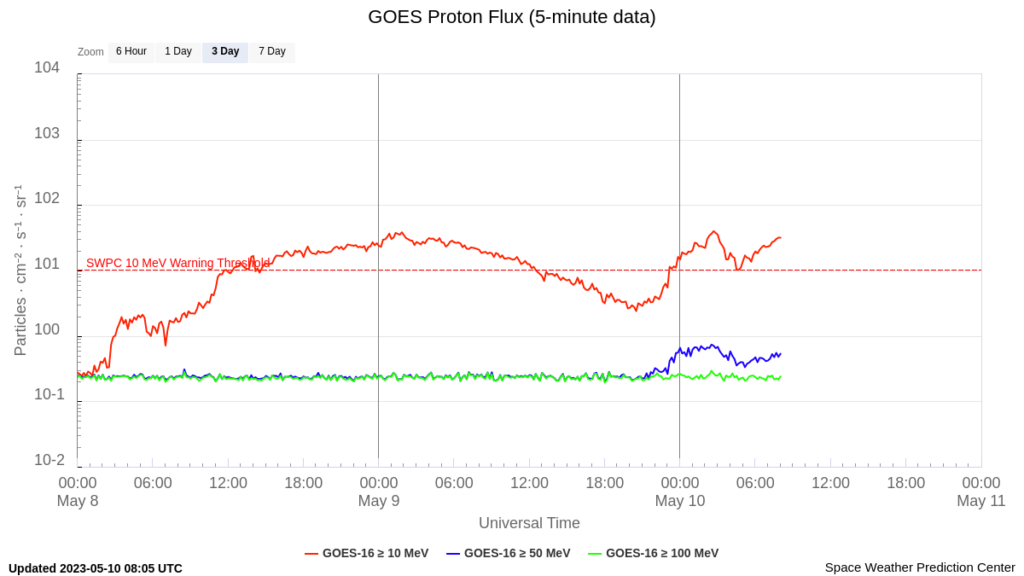
The re-enhancement in the greater than 10 MeV proton flux, due to recent CME activity and May 7 CME arrival, is expected to continue through at least midday on May 10. A decreased chance of any subsequent event exists on May 11, decreasing to a slight chance on May 12, 2023.
The geomagnetic field was quiet to active for most of the day in decreasing response to coronal hole high speed stream (CH HSS) influences. G1 – Minor storm conditions were reached in the last synoptic period of the day, likely in response to the suspected arrival of the May 7 CME.
G2 – Moderate storm levels are likely on May 10 as effects from the apparent arrival of May 7 CME persist. Depending on the CME trajectory, there is a slight, and decreasing chance of G3 – Strong levels associated with the CME effects.
G1 – Minor storms are currently anticipated on May 11, as CME influences continue; however, this forecast may be upgraded based on the analysis of the most recent M4 flare-associated CME. Currently, active conditions are anticipated on May 12 but any CME influences from the most recent CME could continue, and these levels may be upgraded accordingly.
Solar wind parameters reflected a mostly ambient, background state for most of the past 24 hours. Total Interplanetary Magnetic Field (IMF) strength was primarily 4 – 6 nT, and the Bz component underwent primarily weak deviations. Solar wind speed declined from approximately 475 km/s to end-of-period values near 400 km/s.
At approximately 22:10 UTC on May 9, 2023, solar wind parameters indicated a shock passage at the DSCOVR and ACE spacecrafts. Solar wind speeds increased from around 400 km/s to just over 600 km/s, eventually peaking at over 675 km/s. The total field increased to 16 nT, Bz saw a southward deflection to -13 nT, and density increased to peak over 20 ppcm/3.
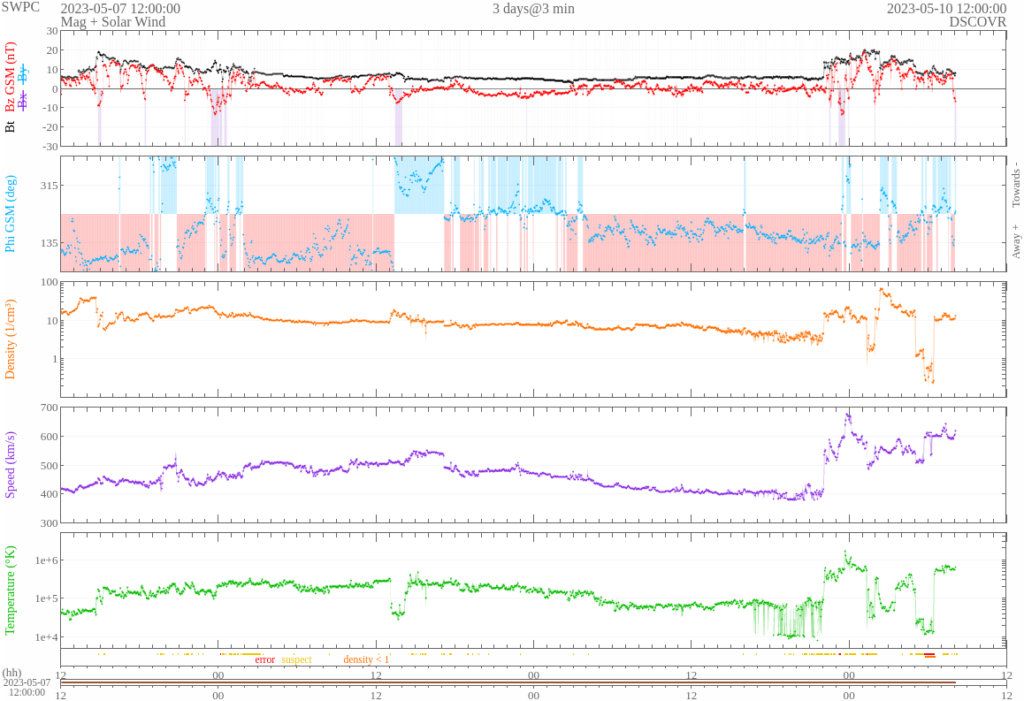
The interplanetary shock signals the likely early arrival of the anticipated May 7 CME. The bulk of the plasma appears to be mainly directed ahead and north of Earth’s orbital location, but CME passage is expected to continue through May 10 before weakening near the end of the day.
Additional CMEs were analyzed today from solar-related events, some with minor Earth-directed possible components. However, the most recent M4 flare-related partial halo CME is the next noteworthy event for a likely geoeffective component. The analysis is underway as we await additional coronagraph imagery. Initial speed estimates of this CME’s driver are over 1 000 km/s, suggesting a potential arrival at Earth as early as May 11, sometime after 18:00 UTC. Any enhanced conditions will likely continue into May 12.
The solar activity is likely to be moderate with a continuing likelihood of M-class flares and slight chance of X-class flares from May 10 to 12, due primarily to the enhanced flare potential of Region 3296.
References:
1 Forecast Discussion Issued: 2023 May 10 0030 UTC -Prepared by the U.S. Dept. of Commerce, NOAA, Space Weather Prediction Center
Featured image credit: NASA SDO/AIA 131. Acquired at 18:54 UTC on May 9, 2023

Commenting rules and guidelines
We value the thoughts and opinions of our readers and welcome healthy discussions on our website. In order to maintain a respectful and positive community, we ask that all commenters follow these rules.